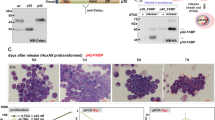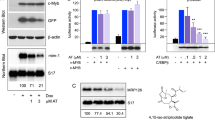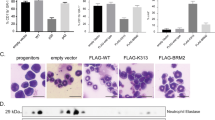Abstract
The arrest of differentiation is a feature of both chronic myelogenous leukemia cells in myeloid blast crisis and myeloid precursors that ectopically express the p210BCR-ABL oncoprotein; however, its underlying mechanisms remain poorly understood. Here we show that expression of BCR-ABL in myeloid precursor cells leads to transcriptional suppression of the granulocyte colony–stimulating factor receptor G-CSF-R (encoded by CSF3R), possibly through down-modulation of C/EBPα—the principal regulator of granulocytic differentiation. Expression of C/EBPα protein is barely detectable in primary marrow cells taken from individuals affected with chronic myeloid leukemia in blast crisis. In contrast, CEBPA RNA is clearly present. Ectopic expression of C/EBPα induces granulocytic differentiation of myeloid precursor cells expressing BCR-ABL. Expression of C/EBPα is suppressed at the translational level by interaction of the poly(rC)-binding protein hnRNP E2 with CEBPA mRNA, and ectopic expression of hnRNP E2 in myeloid precursor cells down-regulates both C/EBPα and G-CSF-R and leads to rapid cell death on treatment with G-CSF (encoded by CSF3). Our results indicate that BCR-ABL regulates the expression of C/EBPα by inducing hnRNP E2—which inhibits the translation of CEBPA mRNA.
This is a preview of subscription content, access via your institution
Access options
Subscribe to this journal
Receive 12 print issues and online access
$209.00 per year
only $17.42 per issue
Buy this article
- Purchase on SpringerLink
- Instant access to full article PDF
Prices may be subject to local taxes which are calculated during checkout







Similar content being viewed by others
References
Kantarjian, H.M., Deisseroth, A., Kurzrock, R., Estrov, Z. & Talpaz, M. Chronic myelogenous leukemia: a concise update. Blood 82, 691–703 (1993).
Gordon, M.Y. Biological consequences of the BCR-ABL fusion gene in humans and mice. J. Clin. Pathol. 52, 719–722 (1999).
Sawyers, C.L. Chronic myeloid leukemia. N. Engl. J. Med. 340, 1330–1340 (1999).
Carlesso, N., Frank, D.A. & Griffin, J.D. Tyrosyl phosphorylation and DNA binding activity of signal transducers and activators of transcription (STAT) proteins in hematopoietic cell lines transformed by BCR-ABL. J. Exp. Med. 183, 811–820 (1996).
Perrotti, D. et al. TLS/FUS, a pro-oncogene involved in multiple chromosomal translocations, is a novel regulator of BCR-ABL-mediated leukemogenesis. EMBO J. 17, 4442–4455 (1998).
Ward, A.C., Loeb, D.M., Soede-Bobok, A.A., Touw, I.P. & Friedman, A.D. Regulation of granulopoiesis by transcription factors and cytokine signals. Leukemia 14, 973–990 (2000).
Orkin, S.H. Diversification of hematopoietic stem cells to specific lineages. Nature Rev. Genet. 1, 57–64 (2000).
Zhang, D. E. et al. Absence of granulocyte colony-stimulating factor signaling and neutrophil development in CCAAT enhancer binding protein α-deficient mice. Proc. Natl Acad. Sci. USA 94, 569–574 (1997).
Radomska, H.S. et al. CCAAT enhancer binding protein α is a regulatory switch sufficient for induction of granulocytic development from bipotential myeloid progenitors. Mol. Cell. Biol. 18, 4301–4314 (1998).
Smith, L.T., Hohaus, S., Gonzalez, D.A., Dziennis, S.E. & Tenen, D.G. PU.1 (Spi-1) and C/EBPα regulate the granulocyte colony- stimulating factor receptor promoter in myeloid cells. Blood 88, 1234–1247 (1996).
Wang, X., Scott, E., Sawyers, C.L. & Friedman, A.D. C/EBPα bypasses granulocyte colony-stimulating factor signals to rapidly induce PU.1 gene expression, stimulate granulocytic differentiation, and limit proliferation in 32Dcl3 myeloblasts. Blood 94, 560–571 (1999).
Scott, L.M., Civin, C.I., Rorth, P. & Friedman, A.D. A novel temporal expression pattern of three C/EBP family members in differentiating myelomonocytic cells. Blood 80, 1725–1735 (1992).
Cheng, T. et al. Temporal mapping of gene expression levels during the differentiation of individual primary hematopoietic cells. Proc. Natl Acad. Sci. USA 93, 13158–13162 (1996).
Kozak, M. Initiation of translation in prokaryotes and eukaryotes. Gene 234, 187–208 (1999).
Lekstrom-Himes, J. & Xanthopoulos, K.G. Biological role of the CCAAT/enhancer-binding protein family of transcription factors. J. Biol. Chem. 273, 28545–28548 (1998).
Lincoln, A.J., Monczak, Y., Williams, S.C. & Johnson, P.F. Inhibition of CCAAT/enhancer-binding proteinα and β translation by upstream open reading frames. J. Biol. Chem. 273, 9552–9560 (1998).
Laneuville, P., Heisterkamp, N. & Groffen, J. Expression of the chronic myelogenous leukemia-associated p210BCR-ABL oncoprotein in a murine IL-3 dependent myeloid cell line. Oncogene 6, 275–282 (1991).
Steinman, R.A. & Tweardy, D.J. Granulocyte colony-stimulating factor receptor mRNA upregulation is an immediate early marker of myeloid differentiation and exhibits dysfunctional regulation in leukemic cells. Blood 83, 119–127 (1994).
Tkatch, L.S., Rubin, K.A., Ziegler, S.F. & Tweardy, D.J. Modulation of human G-CSF receptor mRNA and protein in normal and leukemic myeloid cells by G-CSF and retinoic acid. J. Leukoc. Biol. 57, 964–971 (1995).
Lin, F.T., MacDougald, O.A., Diehl, A.M. & Lane, M.D. A 30-kDa alternative translation product of the CCAAT/enhancer binding protein α message: transcriptional activator lacking antimitotic activity. Proc. Natl Acad. Sci. USA 90, 9606–9610 (1993).
Ossipow, V., Descombes, P. & Schibler, U. CCAAT/enhancer-binding protein mRNA is translated into multiple proteins with different transcription activation potentials. Proc. Natl Acad. Sci. USA 90, 8219–8223 (1993).
Calkhoven, C.F., Muller, C. & Leutz, A. Translational control of C/EBPα and C/EBPβ isoforms expression. Genes Dev. 14, 1920–1932 (2000).
van der Velden, A.W. & Thomas, A.A. The role of the 5′ untranslated region of an mRNA in translation regulation during development. Int. J. Biochem. Cell. Biol. 31, 87–106 (1999).
Kozak, M. Adherence to the first-AUG rule when a second AUG codon follows closely upon the first. Proc. Natl Acad. Sci. USA 92, 2662–2666 (1995).
Ostareck-Lederer, A., Ostareck, D.H. & Hentze, M. W. Cytoplasmic regulatory functions of the KH-domain proteins hnRNP K and E1/E2. Trends Biochem. Sci. 23, 409–411 (1998).
Zou, X. & Calame, K. Signaling pathways activated by oncogenic forms of Abl tyrosine kinase. J. Biol. Chem. 274, 18141–18144 (1999).
Zhang, D.E. et al. Function of PU.1 (Spi-1), C/EBP, and AML1 in early myelopoiesis: regulation of multiple myeloid CSF receptor promoters. Curr. Top. Microbiol. Immunol. 211, 137–147 (1996).
Bellon, T., Perrotti, D. & Calabretta, B. Granulocytic differentiation of normal hematopoietic precursor cells induced by transcription factor PU.1 correlates with negative regulation of the c-myb promoter. Blood 90, 1828–1839 (1997).
Gaiger, A. et al. Increase of bcr-abl chimeric mRNA expression in tumor cells of patients with chronic myeloid leukemia precedes disease progression. Blood 86, 2371–2378 (1995).
Elmaagacli, A.H., Beelen, D.W., Opalka, B., Seeber, S. & Schaefer, U.W. The amount of BCR-ABL fusion transcripts detected by the real-time quantitative polymerase chain reaction method in patients with Philadelphia chromosome positive chronic myeloid leukemia correlates with the disease stage. Annu. Hematol. 79, 424–431 (2000).
Kantarjian, H.M. et al. Chronic myelogenous leukemia in blast crisis: analysis of 242 patients. Am. J. Med. 83, 445–454 (1987).
Cambier, N., Chopra, R., Strasser, A., Metcalf, D. & Elefanty, A.G. BCR-ABL activates pathways mediating cytokine independence and protection against apoptosis in murine hematopoietic cells in a dose-dependent manner. Oncogene 16, 335–348 (1998).
Issaad, C. et al. Biological effects induced by variable levels of BCR-ABL protein in the pluripotent hematopoietic cell line UT-7. Leukemia 14, 662–670 (2000).
Pabst, T. et al. AML-1-ETO downregulates the granulocytic differentiation factor C/EBPα in t(8;21) myeloid leukemia. Nature Med. 7, 444–451 (2001).
Wong, K.K et al. v-Abl activates c-myc transcription through the E2F site. Mol. Cell. Biol. 15, 6535–6544 (1995).
Dai, Z. et al. Oncogenic Abl and Src tyrosine kinases elicit the ubiquitin-dependent degradation of target proteins through a Ras-independent pathway. Genes Dev. 12, 1415–1424 (1998).
Perrotti, D. et al. BCR-ABL prevents c-jun-mediated and proteasome-dependent FUS (TLS) proteolysis through a protein kinase CβII-dependent pathway. Mol. Cell. Biol. 20, 6159–6169 (2000).
Ilaria, R.L. Jr, Hawley, R.G. & Van Etten, R.A. Dominant negative mutants implicate STAT5 in myeloid cell proliferation and neutrophil differentiation. Blood 93, 4154–4166 (1999).
Cazzola, M. & Skoda, R.C. Translational pathophysiology: a novel molecular mechanism of human disease. Blood 95, 3280–3288 (2000).
Thisted, T., Lyakhov, D.L. & Liebhaber, S.A. Optimized RNA targets of two closely-related triple KH-domains proteins, hnRNP K and aCP-2KL, suggest distinct modes of RNA recognition. J. Biol. Chem. 276, 17484–17496 (2001).
Ostareck, D.H. et al. mRNA silencing in erythroid differentiation: hnRNP K and hnRNP E1 regulate 15-lipoxygenase translation from the 3′ end. Cell 89, 597–606 (1997).
Ostareck, D.H., Ostareck-Lederer, A., Shatsky, I.N. & Hentze, M.W. Lipoxygenase mRNA silencing in erythroid differentiation: the 3′ UTR regulatory complex controls 605 ribosomal subunit joining. Cell 104, 281–290 (2001).
Collier, B., Goobar-Larsson, L., Sokolowski, M. & Schwartz, S. Translational inhibition in vitro of human papillomavirus type 16 L2 mRNA mediated through interaction with heterogeneous ribonucleoprotein K and Poly(rC)-binding proteins 1 and 2. J. Biol. Chem. 273, 22648–22656 (1998).
Blyn, L.B., Towner, J.S., Semler, B.L. & Ehrenfeld, E. Requirement of poly(rC)-binding protein 2 for translation of poliovirus RNA. J. Virol. 71, 6243–6246 (1997).
Silvera, D., Gamernik, A.V. & Andino, R. The N-terminal K homology domain of the poly(rC)-binding protein is a major determinant for binding to the poliovirus 5′ untranslated region and acts as an inhibitor of viral translation. J. Biol. Chem. 274, 38163–38170 (1999).
Graff, J., Cha, J., Blyn, L.B. & Ehrenfeld, E. Interaction of poly(rC)-binding protein 2 with the 5? noncoding region of hepatitis A virus RNA and its effects on translation. J. Virol. 72, 9668–9675 (1998).
Pabst, T. et al. Dominant-negative mutations of C/EBPα, encoding CCAAT/enhancer binding protein-α (C/EBPα), in acute myeloid leukemia. Nature Genet. 27, 263–270 (2001).
Westendorf, J.J. et al. The t(8;21) fusion product, AML-1-ETO, associates with C/EBPα, inhibits C/EBPα-dependent transcription, and blocks granulocytic differentiation. Mol. Cell. Biol. 18, 322–333 (1999).
Thomson, A.M., Rogers, J.T., Walker, C.E., Staton, J.M. & Leedman, P.J. Optimized RNA gel-shift and UV crosslinking assays for characterization of cytoplasmic RNA-protein interactions. Biotechniques 27, 1032–1039 (1999).
Gamarnik, A.V. & Andino, R. Two functional complexes formed by KH domain containing proteins with the 5′ noncoding region of poliovirus RNA. RNA 3, 882–892 (1997).
Acknowledgements
We thank A. Bergamaschi and P. Guaraldi for assistance in hnRNP E2 protein purification and REMSA assays; R. Martinez, D.G. Tenen and H. Radomska for helpful discussion; and A. Leutz for communicating his data on translational control of C/EBPα expression. R.T. is supported by a training grant from the National Institutes of Health. C.G. and G.S. were supported in part by the A. Serra Foundation for Cancer Research. This work was supported in part by grants from the NIH (B.C.), from CALGB (M.A.C.) and from the Associazione Italiana Per La Ricerca sul Cancro (C.G.-P.).
Author information
Authors and Affiliations
Corresponding authors
Rights and permissions
About this article
Cite this article
Perrotti, D., Cesi, V., Trotta, R. et al. BCR-ABL suppresses C/EBPα expression through inhibitory action of hnRNP E2. Nat Genet 30, 48–58 (2002). https://doi.org/10.1038/ng791
Received:
Accepted:
Published:
Issue Date:
DOI: https://doi.org/10.1038/ng791
This article is cited by
-
Role of miRNAs to control the progression of Chronic Myeloid Leukemia by their expression levels
Medical Oncology (2024)
-
ABL1 kinase as a tumor suppressor in AML1-ETO and NUP98-PMX1 leukemias
Blood Cancer Journal (2023)
-
Expression level of CEBPA gene in acute lymphoblastic leukemia individuals
Scientific Reports (2019)
-
Targeting transcription factors in acute myeloid leukemia
International Journal of Hematology (2019)
-
NR2C2-uORF targeting UCA1-miR-627-5p-NR2C2 feedback loop to regulate the malignant behaviors of glioma cells
Cell Death & Disease (2018)



